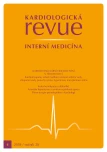The ankle-brachial index in diabetes - what is the most appropriate measurement method?
Authors:
Homza M. 1,2; Machaczka O. 3; Porzer M. 1,2; Kozák M. 4; Plášek J. 1,2; Šipula D. 1,2
Authors‘ workplace:
Kardiovaskulární oddělení, FN Ostrava 2 Katedra interních oborů, LF OU, Ostrava 3 Ústav epidemiologie a ochrany veřejného zdraví, LF OU, Ostrava 4 Interní kardiologická klinika LF MU a FN Brno
1
Published in:
Kardiol Rev Int Med 2018, 20(4): 300-303
Overview
The ankle-brachial index (ABI) is a principal screening tool for the detection of lower extremity arterial disease. In our study with 40 diabetic patients, we evaluated the ability of different ABI methods to detect significant (>50%) stenosis in the lower extremity arteries determined by duplex ultrasonography. According to our results, the ABI obtained through the calculation utilising the lowest of the arterial pressures measured by the Doppler ultrasound at the ankle level (LAP) performed significantly better in this respect than either oscillometric ABI or even the guideline-recommended method that uses the higher of the ankle arterial pressures. For this reason, we believe it would be more appropriate to use the LAP method for screening in diabetic patients. At the same time, Doppler ABI measurement is missing in the Czech Healthcare Procedure Directory. We believe that this procedure should be added to the directory, at least for diabetic patients.
Key words:
ankle-brachial index – ABI – screening – lower extremity arterial disease – Doppler – Czech Healthcare Procedure Directory
Sources
1. Aboyans V, Ricco JB, Bartelink ME et al. 2017 ESC Guidelines on the diagnosis and treatment of peripheral arterial diseases, in collaboration with the European Society for Vascular Surgery (ESVS). Eur Heart J 2018; 39(9): 763– 816. doi: 10.1093/ eurheartj/ ehx095.
2. Rooke TW, Hirsch AT, Misra S et al. 2011 ACCF/ AHA focused update of the guideline for the management of patients with peripheral artery disease (updating the 2005 Guideline): a report of the American College of Cardiology Foundation/ American Heart Association Task Force on practice guidelines. Circulation 2011; 124(18): 2020– 2045. doi: 10.1161/ CIR.0b013e31822e80c3.
3. Gerhard-Herman MD, Gornik HL, Barrett C et al. 2016 AHA/ ACC Guideline on the management of patients with lower extremity peripheral artery disease: executive summary: a report of the American College of Cardiology/ American Heart Association task force on clinical practice guidelines. J Am Coll Cardiol 2017; 69(11): 1465– 1508. doi: 10.1016/ j.jacc.2016.11.008.
4. American Diabetes Association. Peripheral arterial disease in people with diabetes. Diabetes Care 2003; 26(12): 3333– 3341.
5. Massmann A, Stemler J, Fries P et al. Automated oscillometric blood pressure and pulse-wave acquisition for evaluation of vascular stiffness in atherosclerosis. Clin Res Cardiol 2017; 106(7): 514– 524. doi: 10.1007/ s00392-017-1080-7.
6. Špan M, Geršak G, Millasseau SC et al. Detection of peripheral arterial disease with an improved automated device: comparison of a new oscillometric device and the standard Doppler method. Vasc Health Risk Manag 2016; 12 : 305– 311. doi: 10.2147/ VHRM.S106534.
7. Benchimol A, Bernard V, Pillois X et al. Validation of a new method of detecting peripheral artery disease by determination of ankle-brachial index using an automatic blood pressure device. Angiology 2004; 55(2): 127– 134. doi: 10.1177/ 000331970405500203.
8. Beckman JA, Higgins CO, Gerhard-Herman M. Automated oscillometric determination of the ankle-brachial index provides accuracy necessary for office practice. Hypertension 2006; 47(1): 35– 38. doi: 10.1161/ 01.HYP.0000196686.85286.9c.
9. Nukumizu Y, Matsushita M, Sakurai T et al. Comparison of Doppler and oscillometric ankle blood pressure measurement in patients with angiographically documented lower extremity arterial occlusive disease. Angiology 2007; 58(3): 303– 308.
10. Aboyans V, Lacroix P, Doucet S et al. Diagnosis of peripheral arterial disease in general practice: can the ankle-brachial index be measured either by pulse palpation or an automatic blood pressure device? Int J Clin Pract 2008; 62(7): 1001– 1007. doi: 10.1111/ j.1742-1241.2008.01784.x.
11. Wohlfahrt P, Ingrischová M, Krajcoviechová Aet al. A novel oscillometric device for peripheral arterial disease screening in everyday practice. The Czech-post MONICA study. Int Angiol 2011; 30(3): 256– 261.
12. Takahashi I, Furukawa K, Ohishi W et al. Comparison between oscillometric - and Doppler-ABI in elderly individuals. Vasc Health Risk Manag 2013; 9 : 89– 94. doi: 10.2147/ VHRM.S39785.
13. Aerden D, Massaad D, von Kemp K et al. The ankle-brachial index and the diabetic foot: a troublesome marriage. Ann Vasc Surg 2011; 25(6): 770– 777. doi: 10.1016/ j.avsg.2010.12.025.
14. Espinola-Klein C, Rupprecht HJ, Bickel C et al. Different calculations of ankle-brachial index and their impact on cardiovascular risk prediction. Circulation 2008; 118(9): 961– 967. doi: 10.1161/ CIRCULATIONAHA.107.763227.
15. Schröder F, Diehm N, Kareem S et al. A modified calculation of ankle-brachial pressure index is far more sensitive in the detection of peripheral arterial disease. J Vasc Surg 2006; 44(3): 531– 536. doi: 10.1016/ j.jvs.2006.05.016
16. Seznam zdravotních výkonů. Ministerstvo zdravotnictví ČR. Available at: https:/ / szv.mzcr.cz.
17. Aboyans V, Criqui MH, Abraham P et al. Measurement and interpretation of the ankle-brachial index: a scientific statement from the American Heart Association. Circulation 2012; 126(24): 2890– 2909. doi: 10.1161/ CIR.0b013e318276fbcb.
18. Aboyans V, Ho E, Denenberg JO et al. The association between elevated ankle systolic pressures and peripheral occlusive arterial disease in diabetic and nondiabetic subjects. J Vasc Surg 2008; 48(5): 1197– 1203. doi: 10.1016/ j.jvs.2008.06.005.
Labels
Paediatric cardiology Internal medicine Cardiac surgery CardiologyArticle was published in
Cardiology Review

2018 Issue 4
Most read in this issue
- Hypertension in pregnancy
- Heart rhythm disorders in pregnancy
- Diagnosis and management of angioedema
- The ankle-brachial index in diabetes - what is the most appropriate measurement method?
